Been channelling my frustrations into serial form. Enter:
I’m Okay
Autobiographical non-sequitur comic (each piece is a self-contained story), updates Saturdays and (when I have time) Tuesdays.
I’m by no means a professional artist. But I have made art for most of my (so far still quite short) life, and I’ve done calligraphy for just over a year. So I thought I’d share some things I’ve learnt!
The first part: Random tips.
The second part: Sketchbook-related tips.
Firstly. Be organized.
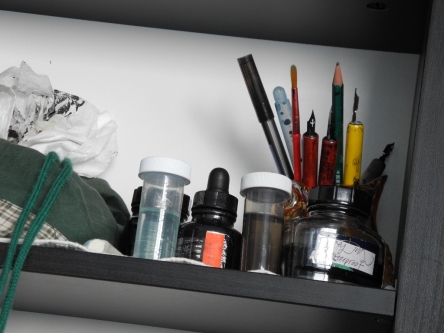
I have a shelf on my desk specifically for my pen-and-ink stuff (most of my drawings are pen and ink, and obviously so is calligraphy). Important things that I’ve found:
An assortment of nibs on an assortment of holders (so I don’t have to keep switching nibs every time I want to use a different one). Call me lazy. But I like the convenience. Plus, nib holders aren’t expensive. The three nibs I use most frequently are Hunt Imperial 101 (for copperplate or other pressure-sensitive calligraphy), Nikko G (for general drawing), and sometimes a flat-edged nib (such as Speedball Left-Cut nibs for calligraphy by lefties like me). I’m no expert on nibs (or really anything else actually :P) so these are just what I’m used to. I’m sure there are others to consider.
My inks. I have one used ink bottle for diluted black ink (and it is labelled), for when I want translucent lines. I have fountain pen ink (water soluble, easy on my nibs) and waterproof ink (for when I want to do something more permanent, want to use watercolours without dissolving my lines, or want to use paper with not-as-good sizing because this ink is also thicker. More on sizing later).
Water. I keep all my used pill-bottles and put water in them, for cleaning out my nibs after use (so I don’t have to keep running to the kitchen/bathroom) and for watercolours. Pill-bottles are also great for ink. They don’t leak, and won’t open in your bag.
A piece of tissue. For cleaning up nibs. One piece of tissue can last months. Or you can use cloth if you prefer.
Eraser(s) + Pencil. If you’re drafting in pencil and going over it with ink, use the kneadable kind of eraser– it’s better on the ink.
A bag containing all my spare calligraphy/pen-and-ink stuff. I could actually keep it somewhere else, but it just happens to be there.
There are related tips. Such as:
Loading a nib with ink: Please please please do not dip the nib too far into the ink such that the holder gets wet too. It will mean having to clean out the nib and holder separately and leaving the holder to dry by itself, or have a rusted nib. Some types of ink contain a pipette for loading the ink. Use it. You can also use a brush to load ink, although personally I’ve not done that yet.
New nibs are coated with a thin layer of wax to stop them from rusting before you get to them. If you don’t clean of this nib, you may have problems with ink flow. How I personally clean out nibs is I boil a pot of water, and let the nib sit submerged in the heated water with some dish-soap. And I scrub it with a used toothbrush. Don’t put it in an open flame– that apparently damages the nib.
Treatment of nibs: Also, do not drop pens nib-first onto a hard surface. You will damage the nib. Also try to avoid dragging them over any hard surface. Sharp-pointed nibs also, I’ve heard, tend to have a shorter life than other nibs, particularly if using it for copperplate (and related) calligraphy– because after a while the nib starts snagging against the paper when pushing it upwards. So I have a whole stock of Hunt Imperial 101s.
Secondly. Have at least one sketchbook/appropriate paper.

Like many artists, I am addicted to sketchbooks. My sibling recently got me a(nother) sketchbook for my birthday. I am currently using 5 of my 7-sketchbooks-and-1-stack-of-cardstock. The paper I use is mostly dependent on what size I want to work in, and the base colour I want (I have white, various hues of cream, and two hues of light brown). As well as what’s not drying out at the moment.
The advantage of sketchbooks as opposed to just loose sheets of paper is that sketchbooks keep my art/calligraphy in chronological order, so you can just look back at your improvement across time. It’s also easier to carry. But if you prefer loose sheets of paper, go ahead and do that.
So, how to choose a sketchbook/paper?
If you’re working with pen and ink, and especially if you’re doing calligraphy (where you generally want crisp edges), pay attention to the sizing of the paper. Not the ‘size’– the ‘sizing’. Sizing is a process that makes the fibres of the paper less absorbent of liquid– so the ink sits on top of the paper, rather than being absorbed into the page and looking fuzzy.
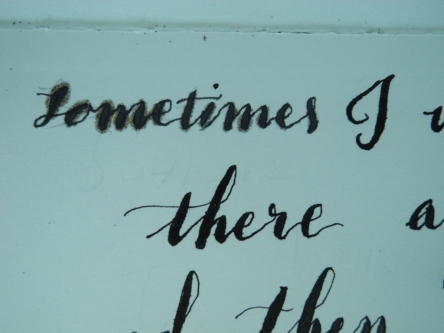
The first word of this picture demonstrates what not to do in terms of matching ink to paper. The sizing of this paper clearly wasn’t enough for the ink in that word (for the record, that was my fountain pen ink, which is thinner, more fluid, than the thicker waterproof ink used for the rest of the words).
So if you want your crisp edges, use well-sized paper!
Also important, particularly if doing calligraphy with a sharp-tipped nib, is the texture of the paper. Rougher papers (such as the bottom sketchbook shown here) are said to have more ‘tooth’.
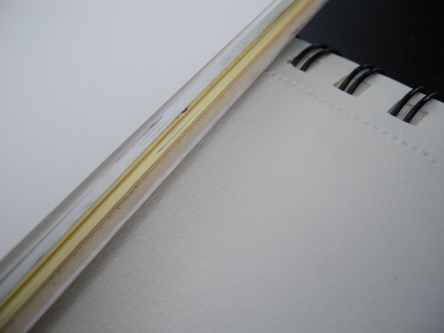
Tooth is all well and good when you’re drawing (in fact I like having tooth when I draw) or painting; but it will catch on a sharp-tipped nib that is being pushed, as happens in calligraphy. And then ink will spray everywhere. So, using a smoother paper is easier for copperplate calligraphy (the fancy loopy one) and related uses of sharp nibs.
The roughness of a paper is also good to consider when using pencils/colour pencils/other dry media.
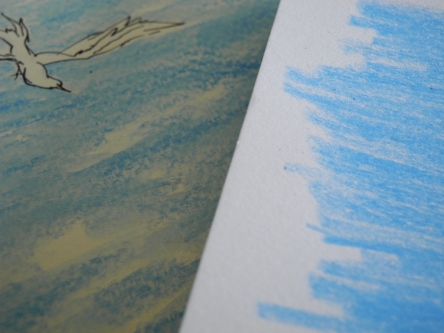
The paper on the right is smoother (has less tooth). I used the same box of colour pencils on both papers– and in the paper on the right, the colour pencil has pigmented the page more evenly (which is what I want in this case). So, it depends what you want for that particular drawing.
Another thing to consider when choosing a sketchbook is how it opens.
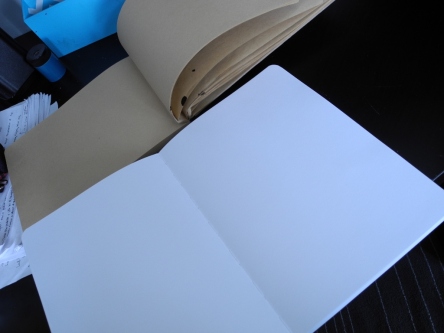
The sketchbook on the top doesn’t lie flat. Which means that I can’t use the whole two page spread. It’s also rather annoying sometimes because I have to keep something on the unused page to keep the sketchbook open.
Generally, stitched sketchbooks (such the one on the bottom in this image) lie flat.
Or, if you want the unused page to be tucked under the page you’re using, go for a ring- or spiral-bound sketchbook.
Other things.
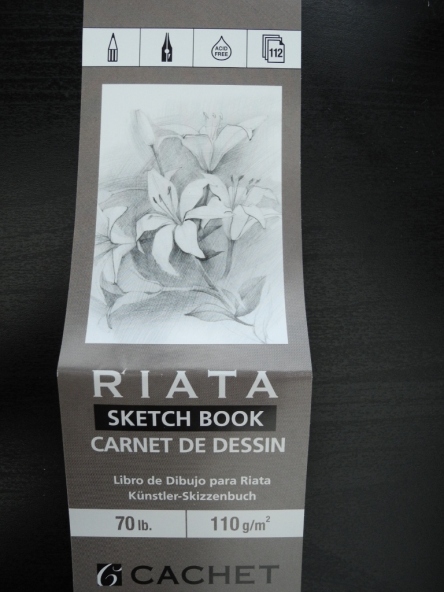
This is the info slip that came with my newest sketchbook. It says a few important things.
The leftmost pictures on the top banner indicate that this paper is suitable for pencil and pen-and-ink. (But don’t pay too much attention to it; I bought one apparently pen-and-ink friendly sketchbook that bleeds and is too rough.) The third picture indicates that the paper is acid-free. Choosing an acid-free paper is important for conservation. It prevents the paper from becoming brittle. The rightmost picture indicates that the sketchbook has 112 pages.
The 70lb. and 110g/m2 indicate the weight of the paper. Lighter paper is okay for dry media, but since I tend to use ink and sometimes watercolour washes, I like a heavier paper. 70lb. is about as light as I’ll go. With better-sized paper, you can apparently go lighter, though. NOTE: The weight and thickness of a paper are different. One of my sketchbooks that has the thinnest pages apparently has a weight of 200g/m2, and believe me when I say it will hold a ridiculous amount of ink without warping.
Incidentally, for reasons I don’t understand, Tim Hortons’ paper bags are great for inking on.
There are many more things that I could include, but honestly I don’t know all that much. This is all I’ve figured out so far. Maybe I’ll update years later with another information-post. Anyhow. Thanks for reading, and enjoy your drawing/calligraphy!